|
|
|
Sort Order |
|
|
|
Items / Page
|
|
|
|
|
|
|
| Srl | Item |
| 1 |
ID:
157470


|
|
|
|
|
| Summary/Abstract |
Proponents of high temperature gas cooled reactors argue that the reactor type is inherently safe and that severe accidents with core damage and radioactive releases cannot occur. The argument is primarily based on the safety features of the special form of the fuel. This paper examines some of the assumptions underlying the safety case for high temperature gas cooled reactors and highlights ways in which there could be fuel failure even during normal operations of the reactor; these failures serve to create a radioactive inventory that could be released under accident conditions. It then describes the severe accident scenarios that are the greatest challenge to high temperature gas cooled reactor safety: ingress of air or water into the core. Then, the paper offers an overview of what could be learned from the experiences with high temperature gas cooled reactors that have been built; their operating history indicates differences between actual operations and theoretical behavior. Finally, the paper describes some of the multiple priorities that often drive reactor design, and how safety is compromised in the process of optimizing other priorities.
|
|
|
|
|
|
|
|
|
|
|
|
|
|
|
|
| 2 |
ID:
142010
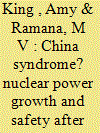

|
|
|
|
|
| Summary/Abstract |
Since the Fukushima disaster in Japan, the Chinese government has undertaken a number of measures to improve the safety of its nuclear facilities while simultaneously committing to a rapid expansion of nuclear power capacity. We explore the tension between these twin commitments, examining China's record of implementation of nuclear safety measures since Fukushima. We investigate how nuclear safety interacts with other priorities in shaping decisions about inland nuclear power stations and nuclear reactor design choice. We find that various safety measures have been implemented since 2011, but where their implementation competes with other priorities— such as the economic interests of local governments and nuclear corporations, and central government energy and development targets—safety is not always the primary concern.
|
|
|
|
|
|
|
|
|
|
|
|
|
|
|
|
| 3 |
ID:
085062


|
|
|
|
|
| Publication |
2008.
|
| Summary/Abstract |
This article explores the safety capabilities of the 500 MWe Prototype Fast Breeder Reactor that is under construction in India, and which is to be the first of several similar reactors that are proposed to be built over the next few decades, to withstand severe accidents. Such accidents could potentially breach the reactor containment and disperse radioactivity to the environment. The potential for such accidents results from the reactor core not being in its most reactive configuration; further, when there is a loss of the coolant, the reactivity increases rather then decreasing as in the case of water-cooled reactors. The analysis demonstrates that the official safety assessments are based on assumptions about the course of accidents that are not justifiable empirically and the safety features incorporated in the current design are not adequate to deal with the range of accidents that are possible.
|
|
|
|
|
|
|
|
|
|
|
|
|
|
|
|
| 4 |
ID:
075373
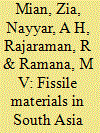

|
|
|
|
|
| Publication |
2006.
|
| Summary/Abstract |
The July 2005 U.S.-India joint statement represents a fundamental transformation of U.S.-India relations and at the same time a challenge to the disarmament and non-proliferation regimes. There is concern that the March 2006 separation plan proposed by India for demarcating its military and civilian nuclear facilities may allow a potentially rapid expansion of its capacity for fissile material production for weapons. In this analysis, we have assessed fissile material production capabilities in India and how they might change as a result of the U.S.-India deal. We look at current stockpiles of fissile materials in India and Pakistan and estimate the changing capacity for future fissile material production as India progressively places some of its heavy water reactors under safeguards. We assess India's uranium resource constraints and the additional weapons grade plutonium production in its unsafeguarded heavy water power reactors that would be made possible by imports of uranium allowed by the deal. We also estimate the weapons plutonium production from India's fast breeder reactor that is under construction and is to be unsafeguarded.
|
|
|
|
|
|
|
|
|
|
|
|
|
|
|
|
| 5 |
ID:
089165


|
|
|
|
|
| Publication |
2009.
|
| Summary/Abstract |
India has long pursued a fast breeder program, motivated in part by the availability of only poor quality uranium resources within the country. But progress so far has been disappointing, with only one test reactor having been constructed and having a chequered operating history. The larger Prototype Fast Breeder Reactor that is being constructed has a design that compromises safety and will produce expensive electricity, but could be used as a way to convert reactor-grade plutonium to weapon-grade plutonium. Projections offered by the nuclear establishment of fast growth of breeder reactors are methodologically flawed and based on very optimistic assumptions.
|
|
|
|
|
|
|
|
|
|
|
|
|
|
|
|
| 6 |
ID:
149611


|
|
|
|
|
| Summary/Abstract |
Tanks holding liquid high level waste from reprocessing spent fuel have large inventories of highly radioactive materials. These tanks could potentially be damaged by a variety of chemical explosions, leading to the dispersion of a significant fraction of their radioactive contents. This article describes some of the different chemical explosions that could occur and examines how such explosions could occur at the Kalpakkam Reprocessing Plant in India, which likely stores a large volume of high level liquid waste because vitrification of that waste did not begin until more than 15 years after the plant began operating in 1998. The atmospheric dispersion of the hypothetical radioactive release is modeled using the Hybrid Single-Particle Lagrangian Integrated Trajectory Model developed by the Air Research Laboratory of the U.S. National Oceanic and Atmospheric Administration. The results suggest that the modeled accident scenario would lead to nearly 97,000 cancers, with roughly 47,000 of these being fatal. Larger radioactive releases are possible and would lead to proportionately higher incidence of cancer and cancer-caused mortality.
|
|
|
|
|
|
|
|
|
|
|
|
|
|
|
|
| 7 |
ID:
073471
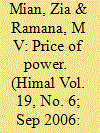

|
|
|
| 8 |
ID:
051740


|
|
|
|
|
| Publication |
New Delhi, Orient Longman, 2003.
|
| Description |
xiii, 502p.
|
| Standard Number |
8125024778
|
|
|
|
|
|
|
|
|
|
|
|
Copies: C:1/I:0,R:0,Q:0
Circulation
| Accession# | Call# | Current Location | Status | Policy | Location |
| 046334 | 355.825119/RAM 046334 | Main | On Shelf | General | |
|
|
|
|
| 9 |
ID:
023488


|
|
|
|
|
| Publication |
March 1, 2003.
|
| Description |
860-863
|
|
|
|
|
|
|
|
|
|
|
|
|
|
|
|
| 10 |
ID:
125504


|
|
|
|
|
| Publication |
2013.
|
| Summary/Abstract |
Canada has a lengthy history of trying to find a path for dealing with radioactive spent fuel and nuclear waste from its nuclear reactors. In the last decade, it has taken major strides towards this goal by evolving a process through which a site for a geological repository to sequester nuclear waste is to be selected. The Canadian Nuclear Waste Management Organization (NWMO) is in the early stages of the process of finding a community that is willing to host such a repository. Differences between the broad principles underlying siting and the processes for actually selecting the site have emerged as the NWMO proceeds with engaging local governments and specific communities. These differences and other conflicts, especially over new nuclear reactor construction, might pose hurdles in the path of successfully setting up a repository.
|
|
|
|
|
|
|
|
|
|
|
|
|
|
|
|
| 11 |
ID:
092728
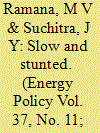

|
|
|
|
|
| Publication |
2009.
|
| Summary/Abstract |
The Indian Department of Atomic Energy (DAE) has projected a large growth of nuclear power in the country predominantly based on breeder reactors. These projections use a simplistic methodology that does not carefully account for the availability of plutonium that is required to fuel breeder reactors. In this paper, we demonstrate that this methodology is problematic, in particular that it would result in negative balances of plutonium if the DAE's projections were to come true. The DAE's projections also ignore constraints coming from reprocessing capacity in the country. As an alternative, we project the possible growth of nuclear power based on breeder reactors using a methodology consistent with plutonium constraints. The resulting breeder reactor capacity will be only between 17% and 40% of the DAE's projections, and will likely never constitute a major source of electricity in India for several decades at the very least.
|
|
|
|
|
|
|
|
|
|
|
|
|
|
|
|
| 12 |
ID:
020552


|
|
|
|
|
| Publication |
Dec 2001.
|
| Description |
28-32
|
|
|
|
|
|
|
|
|
|
|
|
|
|
|
|
| 13 |
ID:
080443


|
|
|
|
|
| Publication |
2007.
|
| Summary/Abstract |
India is building a 500 MWe Prototype Fast Breeder Reactor, which is scheduled to be operational by 2010. India has refused to accept international safeguards on this facility, raising concerns that the plutonium produced in its uranium blankets might be used to make nuclear weapons. Based on neutronics calculations for a detailed three-dimensional model of the reactor, we estimate that up to 140 kg of weapon-grade plutonium could be produced with this facility each year. This article shows how India's large stockpile of separated reactor-grade plutonium from its unsafeguarded spent heavy-water reactor fuel could serve as makeup fuel to allow such diversion of the weapon-grade plutonium from the blankets of the fast breeder reactor. We describe and assess the most plausible refueling strategies for producing weapon-grade plutonium in this way.
|
|
|
|
|
|
|
|
|
|
|
|
|
|
|
|
| 14 |
ID:
150927
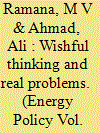

|
|
|
|
|
| Summary/Abstract |
Jordan plans to import two conventional gigawatt scale nuclear reactors from Russia that are expensive and too large for Jordan's current electricity grid. Jordan efforts to establish nuclear power might become easier in some ways if the country were to construct Small Modular Reactors, which might be better suited to Jordan's financial capabilities and its smaller electrical grid capacity. But, the SMR option raises new problems, including locating sites for multiple reactors, finding water to cool these reactors, and the higher cost of electricity generation. Jordan's decision has important implications for its energy planning as well as for the market for SMRs.
|
|
|
|
|
|
|
|
|
|
|
|
|
|
|
|
| 15 |
ID:
067764


|
|
|
|
|
|
|
|